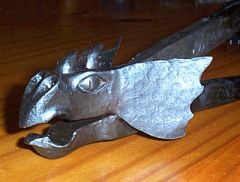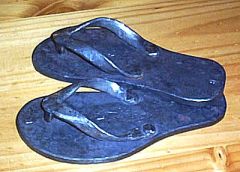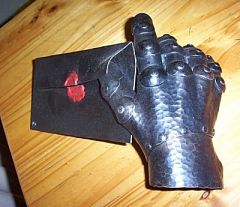-
Posts
566 -
Joined
-
Last visited
Content Type
Profiles
Forums
Articles
Gallery
Downloads
Events
Everything posted by Strine
-
Good suggestions so far but don't be frightened by the tongs. They're not so hard if you concentrate. You do realise if they are seperated and laid next to each other you will mostly have two identical pieces of steel. I know a lot of beginners who shy away from tongs because they can't handle the apparently mirrored parts...which of corse they are not except in special circumstances. At a demonstration, where your masters are probably doing most of the entertaining, it's great to have someone in the background having a go at something new, like tongs. The interaction between the learner and the smith often gets a bit more out of the crowd as well and everybody wins. What ever you do have fun
-
Whoopie, I found how to get the newly posted photos and found these. Posted by Apprenticeman...nice job. But...there's always a but (1 t), they are labelled as "perfect" scrolls. I would maintain that perfection, which I have interpreted here as beauty, is in the eye of the beholder and there are probably quite a few ways to interpret perfection. The eye that I am beholding suggests the top one is more perfect than the second. Beyond the straight section of bar the "line" flows smoothly and elegantly to the tip. Look closely at the second scroll and this point is very obvious. But hey! you might think the second is perfect for one reason or other...no worries mate. Then again we might be talking about the mighty 1.618 In which case I'd like to see some layout details or development formula before accepting the perfectness. So, after I thank Apprenticeman for holding his work up for scutiny the question begs. What is the perfect scroll? For mine, you have my two bobs worth, I like the smooth line and absolutely detest and am disgusted with the scroll with the straight bit on the end. (quick check on photos...phew). Maybe I like it a bit more open. I'm a field mathematician so a cubic spiral or the like gets me going too. Oh, one thing I aim for or appreciate is a continually diminishing gap or space withing the scroll. Any other thoughts on perfect scrolls?
-
A tad off topic but what the heck? I'm the first to admit being a "Try-ard" photographer, but even I could see the compositions here could use some improvement. Somehow or ruther digital cameras just dont do the subject justice. Just trying to be constructive. On the other hand I had a little chuckle at the time warp; maybe that was the intention of the photographer. Well done that person.:)
-

German Republic Order of Excellence
Strine replied to Glenn's topic in Blacksmithing, General Discussion
A feather in the cap...tis good ya. Congrats Uri -
Gee-day and welcome from sunny Victoria (Mexico to you I suppose but I can cope with that)
-
A painted handle is also not good...or so I'm told by an old wife (not mine). Trusting the wisdom of old wives I've never put it to the test. When a handle becomes slippery smooth through use, a lick of linseed oil will fix it..."a little dab'l do ya"
-
I think mine's about 24oz. All I know for sure is that it's about "that" much.
-
When you call up the game about blacksmithing a pop up could appear saying something like get off the computer and find a real smith somewhere.
-
I've just been browsing the blueprints, because I can, and found an interesting one about replacing old sledge handles. Nice one Stephen Fowler (BP296). In the past I have had the good fortune to work with young folk who have little or no experience in swinging a sledge hammer with any sort of accuracy in hitting a survey peg. (Kids just don't learn the basic necessities of life anymore). So there were always handles that needed replacing. Much of the time taken for the repair was in removing the old handle. To speed the process and to extend the life of the various wood chisels, screwdrivers, drill bits etc that were being mangled in the process I came up with a half drift. This was simply a length of decent stuff forged down to a half moon shape. The idea was to drive out only one half of the reamaining handle. As the long wedge had already split the handle it was easy. There was no need to remove any wedges and the whole operation took a few seconds. Yes...I was paid for the boost to company profits... with the usual jabs at the old bloke for having 'bin around' longer than the youngies. And no...the old handles didn't go to waste. PS. As I proof read this I wonder whether the idea didn't come from the net in the first place. I apologise for standing on anyone's foot
-

Photos of BAWA's workshop.
Strine replied to Crackers's topic in BAWA Blacksmiths Association of Western Australia
Gee you're lucky Mr Smith, We have a membership that's fluctuated from 120 down to 60 or 70 and back again over the years and have a "core group" I would generously estimate at half a dozen. I put it down to the overwhelming diversity of interest in "blacksmithing". What ever the committee do it will never entice everyone to get together at the same time. Strangely, it would seem, banging hot metal doesn't seem to be the common theme of the interest. Maybe the committee should reconsider what they offer as far as why we should all get together....now now, moosn't groomble! -
Whack me into the dirt camp. Mix a bit of cow dung into it to keep the flies away from your noggin.
-
I just had a gander at Blueprint 292 by Gerald Franklin and was blown away. $700 for a Stetson tittfa :eek:. That's $US I presume which makes it about $950 in our money. I shudder at the $AU114 for my trusty Akubra. Seems to me a hat hook is not what is warranted, a locked glass cabinet would be more in order. Where would you wear a hat costing more than an arm and a leg; surely not in the sun where it might fade or in the rain where it might get wet. I s'pose it shouldn't be used for fanning the fire or as a make do water bowl for the dog either. I'm just flabbergasted. By the way, nice hat hook and blueprint Gerald
-
IForgeIron Blueprints Copyright 2002 - 2007 IFORGEIRON, All rights reserved BP0295 Nail in hooks by Strine Photos by Rachel There has been an influx of hooks among the blueprints and not wanting to be left out I make my humble offering. It’s just a Nail-in-Hook and takes just about as long as an onlooker can be bothered on looking. Thanks that fella who came up with the original design. And thanks ‘Siss’, aka Rachel, my daughter for looking after the photography. This is really starting from the beginning. I’m using a length of 3/8 rod for this project and the first task is to cut off the daggy end that was left over from the last job. The rod is driven almost through onto the hardy. Be careful here as your hardy will probably leave a nice scar across your hammer if you go too far. The last little bit will virtually fall off but because it was still a bit hot it took some extra wiggling. As an aside let me say that rules, especially safety rules, exist for very good reasons and only when you are totally familiar with them and with the consequences should you ever temp fate. Dear beginners what is wrong here? You're right. Remove the hardy if not in use lest you subtract a knuckle from the tally God gave you. Where possible a good idea is to use round stock if you want square and square if you want round. This gives the whole piece a forged look rather than just the bits you’ve hammered. Here I’m turning the round into square by first flattening about three inches. And what about the new Father’s Day hammer? Don’t tell Siss but I prefer the old one. Turn 90 degrees and finish squaring up the rod. Bend about 1 inch over the edge of the anvil. Without any assistance to hold down the part on the face of the anvil it will kick up. Just belt it down. Here we are about three quarters of the way. Aim for a bend of about 75 degrees With another heat, quench about three quarters of the short section then drive in into the anvil face. In this step the object is to work up a square corner. The squarer the better in the finished piece I reckon. If it is nice and square, when it is nailed in, the hook will appear to be magically attached to the wall or post. Also, if it’s square it won’t get damaged much when it’s hammered in. Now to forging a point to nail in. Start with the work on the face and taper that dimension then… …hook it over an edge and taper the other dimension. There is latitude in this step to get the square corner just as you like it but be careful not to go overboard and ruin it instead. At this stage my nail-in-hooks look a bit like this. Cut off about 3 inches from the ‘nail’ Remember we only squared up about 3 inches of the 3/8 rod. In this step square up the rest and begin to forge a fine point. That is fine enough, we’re not making acupuncture needles. Scroll the point by nudging it over the edge of the anvil while feeding forward. Oh…and if you want to know what “choking a hammer” is all about, this picture explains it pretty well! But it’s a matter of control and here we needed all that could be mustered. A hammer without a handle would have been even better. Eventually you must turn the thing over and coax the scroll around by hitting straight on the end. Take another heat and with a bending fork begin to make the hook part. It’s a good idea now to always quench out the scroll…it’s pretty fragile when confronted with a two pounder in full swing. It just cringes in fear and destroys itself. It won’t be your fault it does it on its own. Finish off the hook over the horn. WATCH OUT FOR THAT SCROLL! Almost done. The twisting photos didn’t turn out, Siss says sorry Dad. I generally do the twisting with two stout pairs of tongs but the vice and shifter work just as well. This picture at least shows the result. It also shows an experiment I thought I’d try. At a black heat the hook is getting a spray with “Lanotech”. It’s just lanolin in a can. You never see a rusty shearing shed so it must work. And this is the finished article. I think I’ll be using the Lanotech again. Footnote: There are a few blueprints about that describe a pineapple twist. Part of making this decorative twist is to know how many twists you've made in the first step so that you can untwist it by half that number. The hook described above has a half twist ie one end has been turned 180 degrees relative to the other end. The number of diagonal lines on any face gives this info immediately. In the hook you will see two diagonal lines therefore it's a half twist....two being half of four. Had there been six diagonal lines it would have received one and a half full turns...six being one and a half times four. If you were using hex material the four in the calculation would become a six. View full article
-
Good on you JW. I've always wondered for what purpose a bridge is covered. They look charming and make nice backdrops in romatic movies but surely that's not their main purpose.
-
Ian, Isn't that the van I saw rolling off into the sunset down Ingrams Rd, Coldstream? (Chopper will explain.) Gee it looks like it is. Logan Village Queensland (Hot Iron Muster) is a fair ways away from Victoria. Folks, it's the same as the trip from Texas to the Canadian border, only you only travel in three states not six and there's some ripper beaches along the way if you take the coast road...Eyes front Ian!
-
IForgeIron Blueprints Copyright 2002 - 2007 IFORGEIRON, All rights reserved BP0280 Billy Hook, tripod Adjustable Billy Hook - Putting Eyes to Good Use by Strine BP0006 “Campfire pot holder” got a recent airing and I thought this article might make an interesting blueprint as well. This shows the whole tripod but it's how the height of the pot is adjusted that I reckon makes this worth adding. The hook is the long bar with a handle bent at right angles. It can be positioned at any height, limited only by the height of the tripod and the length of the hook. The first one I sold was to a mechanical engineer…he'd never seen such a thing. And I suppose that's where the appeal is; not in that it can hold a pot over the fire. Shown is the business section of my infinitely adjustable campfire hook. It's even more infinite than the usual chain and hook arrangement. As you may pick from the photo it consists of … a) a part with an eye on each end and another part with an eye on the end and a double eye or a “wrap” a bit further back. All the material is 3/8 round. About all I can say in relation to dimensions is that the triangle you can see is pretty much equilateral… all the sides are the same length. Yes OK, all the angles are the same as well. This is the view from the other side. The thing is based on an old locking principle the name of which escapes me. It is not just a matter of knocking out the eyes, putting it all together and hoping it will work; i.e. that the bottom eye will grab the shaft of the hook. The easiest thing I found to do was get it roughly right then tweak it in the vice when cold. Here we see the hook all the way down. To get it there you lift up the bottom eye. If you're not careful it will just crash all the way to the handle. …and to lift it all the way up just haul up on the handle. That's the secret; it goes up easy but doesn't go down because any weight locks the hook between opposite sides of the bottom eye. This is where the tweaking in the vice comes in. It has to be just so to work. This is looking from above. Hopefully the orientation of all the eyes is a bit clearer. The hook hangs free in the adjusting gismo but the adjusting gismo has to hang from the head of the tripod. Anyone for a billy of tea? That's an old dunny can (about 8 gallons or about 70 pounds) full to the brim. My Mechanical Engineer mate tells me the legs will collapse long before the hook lets go. The legs are actually starting to bow with this weight but it's hard to tell. All we need now is a blueprint on turning eyes. View full article
-
ThomasP I thought your response was a little timid, I would have gone with BUY IT??????
-
Just doesn't seem to have the same effect as receiving one from the betrothed on the the big day! Nifty idea though. Unfortunately all our coins come with a pikky of the Queen of England on the face. It's an offense to disfigure the old duck as this exercise would surely do.
-
Fair go Rich "thousands of hapless farmers and homeowners" could straighten out all their bent nails on it rather than buy new ones:)
-
Would you believe frock or trouser patterns.
-
I don't think these torches were ever intended to do what an oxy/acet set does. I use one to mostly to heat up a soldering iron Does yours have two opposing bits of tin on the side of the torch where you could balance a piece of 5/8 round that has a lump of copper on the end and a wooden handle on the other? Ive used it too, on occasion, to bend wood. They are very handy if only used up to their limits...isn't everything?
-
Apprenticeman...it depends on your passion. What is gridiron, is that football? I've never heard any other code called "footy" though. We also have two forms of rugby which I suppose is another football code. But that's played by the thugs, er... gentlemen up north.



